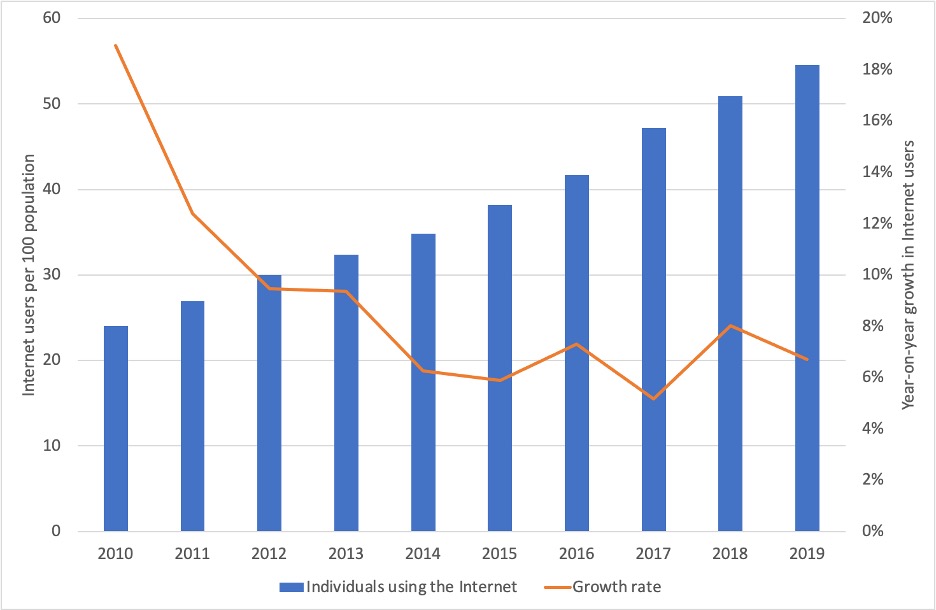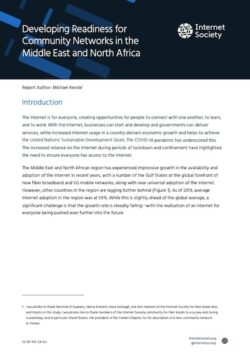Report Author: Michael Kende
Acknowledgements: I would like to thank Nermine El Saadany, Hanna Kreitem, Hana Sabbagh, and Amr Hashem of the Internet Society for their leadership and inputs on this study. I would also like to thank members of the Internet Society community for their inputs to a survey and during a workshop, and in particular Sharaf Azzain, the president of the Yemen Chapter, for his description of a new community network in Yemen.
The Internet is for everyone, creating opportunities for people to connect with one another, to learn, and to work. With the Internet, businesses can start and develop and governments can deliver services, while increased Internet usage in a country delivers economic growth and helps to achieve the United Nations’ Sustainable Development Goals. The COVID-19 pandemic has underscored this. The increased reliance on the Internet during periods of lockdown and confinement have highlighted the need to ensure everyone has access to the Internet.
The Middle East and North African region has experienced impressive growth in the availability and adoption of the Internet in recent years, with a number of the Gulf States at the global forefront of new fiber broadband and 5G mobile networks, along with near universal adoption of the Internet. However, other countries in the region are lagging further behind (Figure 1). As of 2019, average Internet adoption in the region was at 55%. While this is slightly ahead of the global average, a significant challenge is that the growth rate is steadily falling—with the realization of an Internet for everyone being pushed ever further into the future.
Figure 1: Internet adoption and growth in Arab States[1] (Source: ITU, 2021)

There are several reasons for low adoption rates and for the slowing growth rate in adoption. These include that the Internet is not affordable for many people with lower incomes, that the quality of the Internet is poor, and a lack of confidence among potential users in their digital skills to go online. This holds in areas that already have mobile or fixed broadband coverage, including in dense urban areas with high levels of poverty.
However, a more fundamental reason is a lack of availability of Internet access in a geographic area. The Internet is not always commercially viable in areas with high cost of deployment or low-income levels among the population. This is often true in rural areas with lower population concentration, typically below the average income levels in the country. However, in urban areas where there is access it may not have the quality people need to fulfill their needs or it could be unaffordable for people with lower incomes.
Community networks are an increasingly popular solution to these challenges. They provide connectivity in underserved and un-served areas. These are Internet networks that are developed by and for their communities, and which can play an important role in providing access and capacity building where there is little or none. Rather than waiting for the Internet to eventually reach their community and meet their needs, the communities build a local network to reach the Internet.
For over a decade the Internet Society has promoted the development of community networks all around the world. With this paper the Internet Society seeks to develop readiness for the emergence of community networks in the MENA region. It is important that community networks operate within the relevant regulations in their countries. However, it is also important that policymakers and regulators recognize the benefits of community networks and adapt policies where feasible to enable them to develop. This paper aims to highlight the need for community networks in the Middle East and North Africa and the beneficial policies that can create an enabling environment for them.
Community networks offer significant benefits. First, the community network provides access to the Internet to communities where commercial service providers are unable to deliver connectivity within their business models. This allows the people who live there to realize the full benefits of the Internet for work, education, government services, entertainment, and communications, among other uses. Second, more deeply, a community network is not just for community members, it is developed by the community members. It provides training in developing and operating a network and it offers services that can be used in other communities or for more training and job opportunities.
Establishing a community network typically requires support at three levels.
- Community level: This includes those wishing to use the Internet, as well as those willing and able to develop and operate the network. There must be demand among the users for Internet access, which must sometimes be developed, and training in digital skills to use the Internet. In addition, the developers of the network require technical knowledge and training.
- National level: This includes policymakers, regulators, and the telecommunications operators. Ideally, these stakeholders understand the benefits and needs of a community network and make the environment ready for their efficient and affordable development. However, in many countries it is still a new concept, and developing readiness is essential.
- Catalysts: Stakeholders are needed to promote the development of community networks in their country, acting as a bridge to help develop demand for the networks at the community level while creating readiness at the national level. Internet Society chapters in countries often take this role, which can also be taken on by individual champions. This paper provides an example of how this is taking place in Yemen.
The Internet Society has identified significant demand for Internet access in rural and urban areas in the MENA region that could be addressed with community networks. While we could only identify nascent efforts at developing community networks, we have found communities interested in developing them, along with organizers who can help to catalyze the development. This report is targeted at the national level to help to create the environment in which community networks can be developed. (The Internet Society has other resources to help catalysts and communities develop the network once the environment is ready.)
Endnotes
[1] Arab States is the ITU regional classification that corresponds with MENA.

